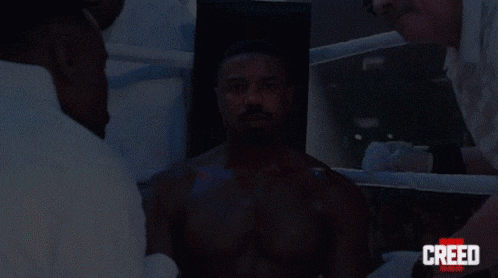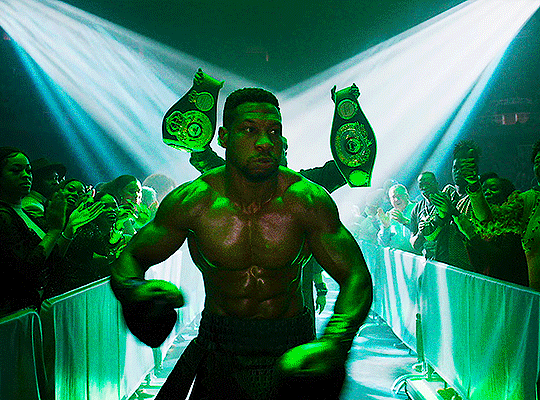How Creed III (and a Tamil film) punched life back into the cliched boxing genre

Sarpatta Parambarai and Creed III are reinventing the boxing genre (photo-DailyO)
An underdog. Training montages. A female love interest for emotional support. Slow-mo punches with sweat and blood dripping on the ring. And probably a real-life boxer-wrestler cameo. For the decades after 1976’s Rocky and 1980’s Raging Bull, this has been the standard recipe for almost every boxing flick including the latest installment of the Creed franchise which obviously is an offshoot from the six-film Rocky series.
Every now and then, there are a few exceptions to the genre such as Million Dollar Baby or Real Steel (a clever take on the one-line thought: “What if robots could box?”). In India, the difference between a cliched boxing drama and a subversive one was starkly evident in the summer of 2021.

It was in mid-July of that year when Farhan Akhtar showed off his ripped physique in an otherwise bland formulaic genre entry called Toofan. The Hindi feature was released directly on Prime Video but that month, the streaming service was blessed with a far more superior boxing story, Pa Ranjith’s glorious three-hour-long drama Sarpatta Parambarai. In fact, just yesterday (March 6), Ranjith announced that Sarpatta 2 is very much under the works!
Inspired by the real-life boxing “clans” of Tamil Nadu, the film delves into an amusing Emergency-era blend of local and European boxing. While sprinkling his usual Ambedkarite visual references, Ranjith frames his hero as more than an underdog. Leading man Aarya’s Kabilan is a man who does get bent out of shape eventually and even resorts to alcoholism. At one point, he falters as both a boxer and a family man eventually paving the way for a dramatic comeback.
And no, this is no Raging Bull-style self-depreciation but full-fledged shot at winning back his ring glory. The story is formulaic but it is what happens in between that sets it apart from the pantheon of boxing films.

To get back into shape, Kabilan also goes through grueling training montages, a genre staple that has been trademark with Sylvester Stallone’s Rocky’s running on the roads of Philadelphia. But it is Ranjith getting innovative with cliches that worked in Sarpatta’s favour. With rapper and Castleless Collective alumnus Arivu’s Neeye Oli playing in background, we see a grumpy old trainer (again, another boxing cliche) making Kabilan run on a beach, unleash punches at aggressive waves, and try to catch crabs on the shore (it’s way more arduous than you would expect).

And it was not just Kaliban, even Ranjith’s other boxers made for some innovative fight choreography. For instance, one of the hero’s early opponents included the boxer nicknamed as “Dancing Rose”. Inspired by British boxer Naseem Hamed, Rose is incredibly fluid in his moves and dodges punches with the finesse of a dancer.
The freshness of Sarpatta hence served as a drastic contrast from cliched boxing ventures such as Toofan that centered around a street thug-turned-boxer who falls from grace and (drumroll) tries to make a career comeback later. Despite Akhthar’s noteworthy physical transformation, there was no individuality to make his character or his fighting style stand out. The same can be said for similar Hollywood boxing features such as Southpaw which again featured Jake Gyllenhaal giving it his all but the same old comeback formula failed to offer anything new.
Throwing in a political or personal angle can always help in adding something more than the cliches. Rocky IV did that well, doubling as an over-the-top Rocky adventure as well as an effective Cold War propaganda tool. Regardless of your views on American hegemony, Rocky IV is quite an amusing continuation of the franchise. Rocky already had his underdog moments with the early films. Now, facing off a gargantuan Russian opponent like Ivan Drago right in the midst of the Cold War is arguably interesting plot development.
While the Rocky films might have overstayed their welcome with Stallone’s self-indulgence, it is worth noting how every film tried to do something new. Rocky V found its titular boxer turning coach while Rocky Balboa found the aged champ somehow returning to the ring again with a surprise exhibition fight. Even though the sixth film managed to garner positive reactions, it was high time for Stallone to tap out of the ring after this.
And then…came the announcement for a new franchise focusing on Rocky’s rival-turned-friend’s son Adonis Creed. The Creed series could have very well been another shameless money-making property for its studios but the trilogy turned out to be way more than that.
Most of the audiences who identify themselves as “cinephiles” would argue that the creative direction of the Creed films might be far more superior than the original Rocky series which is beloved more for its emotional and dramatic aspects than the technical details. But with Creed III more than the earlier two films, the entire Rocky mythos and the boxing genre has definitely reached a new high.
Creed III continues its franchise and genre’s traditions like a boxer’s post-retirement dilemma of making a comeback, going out of shape (and then getting back to it), and of course, the good, old training montage. With leading man Michael B Jordan also making his directorial debut with the third chapter, a lot was riding on it.
Just like how a few cinephiles might have asked themselves “Do we still need yet another gangster flick?” after Martin Scorsese’s The Irishman (I still ask that as, full disclosure, I’m not the biggest Irishman fan), it is quite natural to ask yourself “Another boxing film? Another Rocky-Creed film? What’s new?”.
But right from Creed III’s opening frames, Jordan and his talented crew have managed to subvert the genre in wildly imaginative ways. By now, it is public knowledge that Jordan is a “weeb” (avid anime enthusiast) and he has drawn inspiration from several legendary anime series such as Naruto, My Hero Academia, Dragon Ball Z, and of course, Hajime no Ippo which itself is a boxing anime.

In Creed III, he gets to fully utilise the fast-paced anime jump-cuts and dramatically ambitious framing for some spectacular fight scenes. The anime influences aside, what makes Creed III’s in-ring fighting so visually impressive is the fact that there is an intense focus on the characters and their emotional expressions even in the middle of fights. The familiar lighting-fast perspective switches between the two fighters is also balanced out with moments of individual character development within the ring, perfectly brought out by cinematographer Kramer Morgenthau and his inventory of IMAX-certified Sony CineAlta Venice cameras .

While a generic boxing film’s slow motion scenes tend to focus on falling fighters (complete with the sprinkling sweat and the flying, blood-stained mouthguard), Creed III resorts to some introspective moments with slowed-down time. For instance, the viewer can find moments where Jordan’s Adonis Creed and his opponent Damian Anderson (played by a terrific Jonathan Majors) are just looking at each other in the middle of the punchfest, the background blurring with every second while the details on the fighters’ spaces getting clearer than ever.

Not to delve into explicit spoilers, the word “checkmate” is an integral trope in the film which only comes out further with Tyler Nelson and Jessica Baclesse’s editing. The duo turn the adrenaline-fueled sport of boxing into a game of chess. There are moments when you can land a major victory but that game-changing move comes with some strategic calculation that is brilliantly interspersed with the otherwise lightning-speed combat.
Yes, Creed III’s anime or video-game-like visual vision might not accurately replicate an actual boxing match but that is the beauty of the cinematic language, to turn a violent sport into a graceful dance of differently-timed cuts and visually-expressive character motivations. Just because Adonis and Damian are enemies both inside and outside the ring doesn’t necessarily imply that they are just staring at each other with rage. They have their moments of just blankly or even pitifully analysing their own personal fears and motivations.

The overall product is arguably melodramatic but Jordan does succeed at serving the same dish but with a slightly-altered recipe. Even though the boxing genre (or even the sports drama genre as a whole) might have gotten bland over the years, cases like Sarpatta Parambarai and Creed III offer ways to play around the familiar narrative and visual tropes that have otherwise been plaguing the genre.

